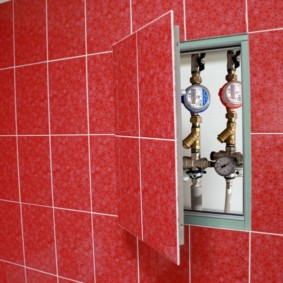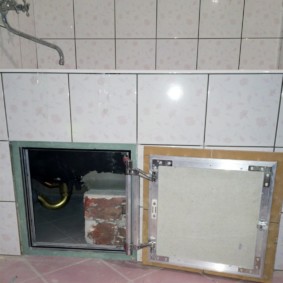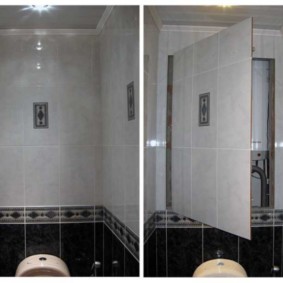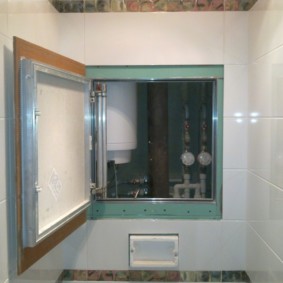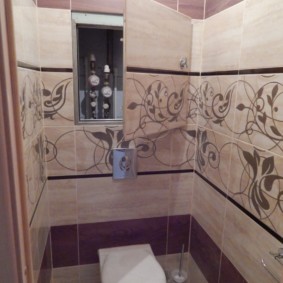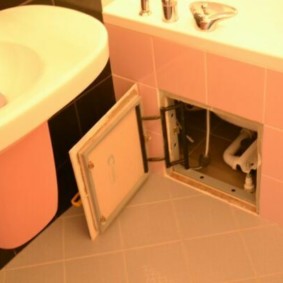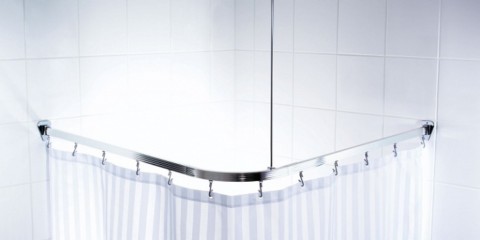 A bathroom
We use decorative plaster in the bathroom
A bathroom
We use decorative plaster in the bathroom
There are so many finishing materials on the modern construction market that every buyer is able to find the material that can easily implement any design ideas. In stores you can find repair products that will fully reflect the essence of technological progress, but there are those that have been used for many hundreds of years, and still compete with modern finishing products. For example, it is a tile for facing surfaces of a bathroom and other sanitary rooms. It was used in the Middle Ages, and it still remains the most popular finishing material. In modern bathrooms, the aesthetic component is very important. pipes, siphons, drain risers must be hidden. But communication lines must be available. And this can help the hatch for the bathroom under the tile.

The hidden hatch is a special device installed in the wall of the duct and masking pipes, valves and other plumbing equipment
About the types, functions and difficulties in choosing a hatch for the bathroom will be today's article.
The main functions of the audit windows
Content
But what exactly are hatches for a bathroom under a tile that they are. This is a kind of product assembled in the form of a box, which is designed to mask pipes, siphons and other means of communication. At present, for example, risers are masked by boxes, for example, all cold and hot water meters, ventilation lines and other horizontally located communication lines are hidden in them.

The hatch is a small door, opening which you can get access to communications, without violating the integrity of the finish
Hatches for a bathroom under a tile have different designs. The door opening mechanism, the materials that make up the hatches in their manufacture are one of the few parameters by which the hatches differ from each other. But all such products have one common resemblance: you can lay tiles on the door, because it is covered with a special material that is compatible with styling.

After installing the hatch, its outer surface is closed with tiles, wallpaper or painted in accordance with the decoration of the bathroom
Let's analyze several functions of the revision windows:
- They provide direct access to meters that record the flow of hot and cold water. If you have a similar box, then you have access to data at any time of the day or night, and numerous wires and pipes do not call your eyes. At the same time, the counter values remain confidential.
- If any communication line breaks, access will be open to it. You can easily fix it yourself or with the help of plumbing services.
- Using the hatch for tiles under the bath, you can easily increase storage space and hide in the resulting box household chemicals, powders, plumbing tools. Also, such a product is able to provide direct access to cleaning and servicing the siphon of the bathtub or sink.

Countersunk door for easy access to meters
Classification: materials, sizes and more
- Materials For the manufacture of hatches and their boxes in the bathroom, materials resistant to high humidity and temperature extremes are used.Some of the most durable products are made of steel, of course, stainless steel, but such hatches cost much more than their analogues on the market. If you are limited in the budget for the repair of the bathroom, then the optimal solution for you is to use plastic models equipped with the simplest opening mechanism for doors. Also, if necessary, it is not at all difficult to assemble the main components of this device yourself from improvised materials.

Metal hatches are suitable for facing with ceramic tiles
- Sizes. I think that everything is clear that the dimensions of the box and hatch are selected individually, based on the area of the space that needs to be hidden, and it, in turn, depends on the dimensions of the plumbing pipes, meters and other devices. On the market, the sizes of hatches for bathrooms start at 10x10 centimeters and end at two meters. If more boxes are needed, then no one forbids them to order.
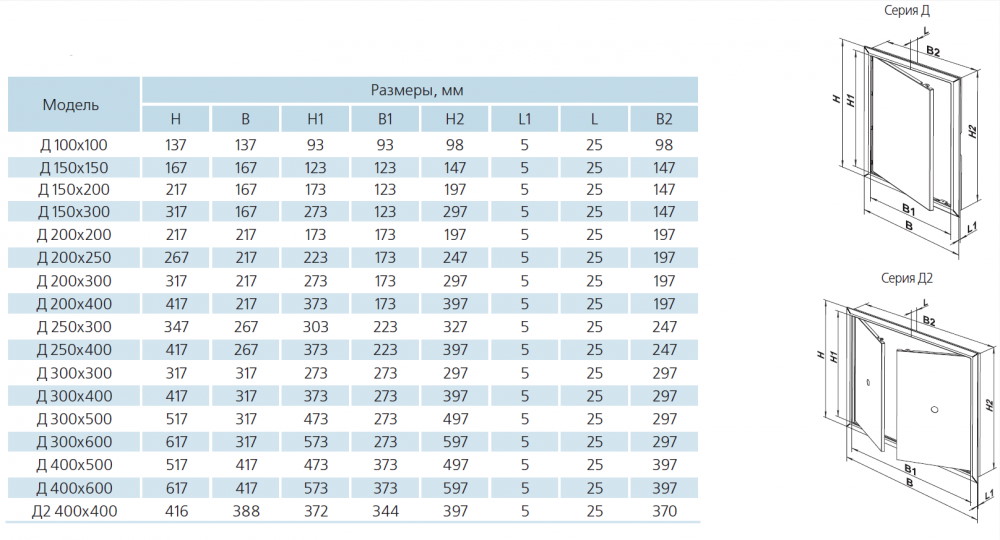
Standard Sizes of Tile Hatchways
How to choose the position of the viewing window and its opening side
Floor hatches are used as a door with which access to the basement is opened. Such structures should be as durable as possible, so steel in their composition comes first. They must have a reliable cover and elements ensuring the tightness of the frame. The floor hatch easily hides behind such a de-flooring as the floor lining in the bathroom.

The sunroof is a sturdy construction that can withstand high loads.
Wall hatches are mounted in special boxes that mask vertical pipes, with the help of them niches are created for storage and organization of free space.
Ceiling devices can be placed in the construction of suspended plasterboard ceilings. They provide access to ventilation systems. Ceiling hatches are lightweight, therefore made of plastic. The doors close firmly.

Ceiling hatches are not subjected to significant load, and therefore are made of less durable materials.
Ceiling structures are slightly different from products designed for walls. They require additional elements, brackets and chains to ensure safe operation. After all, a ceiling structure without support can open and hit a person on the head.
The assortment of construction stores presents models that, in the dark, can be illuminated around the perimeter, playing the role of a night lamp.
Design Differences
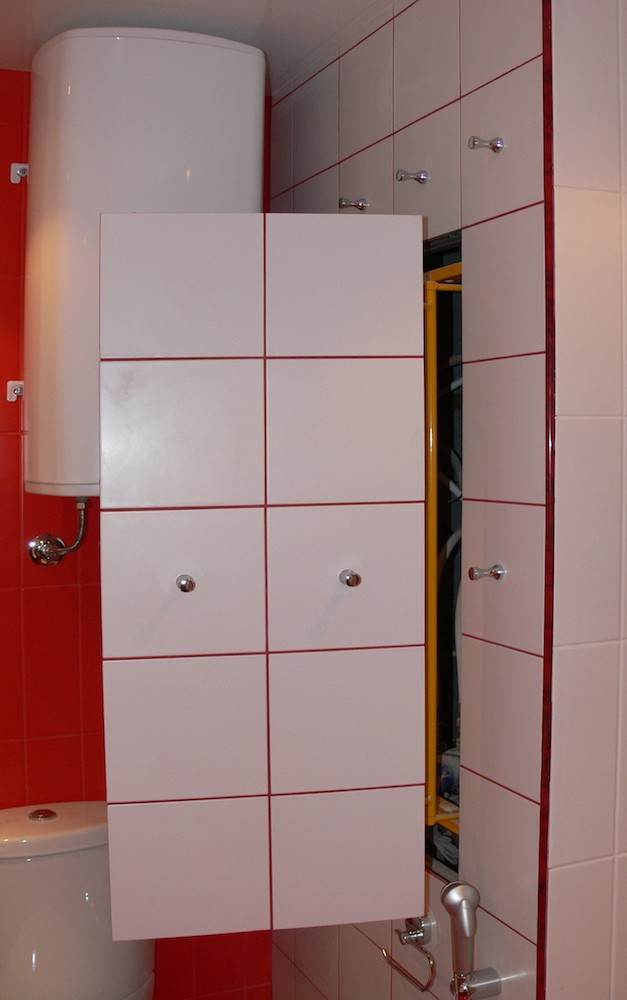
Among all models, push hatches and doors with magnets are most popular.
Magnets hatch
Magnets can be installed in all types of hatches, such as wall, floor and even ceiling. They are able to withstand tremendous loads and heavy weight, which is especially important for floor models.

Magnet hatches are inexpensive, but not very convenient to use.

The main advantage of this design is that it is easy to do it yourself
The mechanism of the magnetic structure is a supporting frame on which magnets are tightly attached, the door is a separate component that is attached to the supporting frame. Subsequently, such a frame can be decorated under the tile, which is decorated with the rest of the interior of the bathroom. But for this you should use a suitable glue.
The press hatch under the Aluklik-M tile
If you chose a newfangled mosaic tile for decorating the bathroom, then keep in mind that it may not stick tightly to the plastic door of the box. For such a tile, a hatch is more suitable, which opens by pressing the door with a hand. The advantage of this type of hatches is that you do not need suction cups to open the door.

The AluKlik-M pressure hatch is characterized by reinforced hinges, which allow facing the external panel with any heavy materials

The device hatch “AluKlik-M”
Mounting the pressure hatch under the tile
Video: Do-it-yourself hatch for tiles on magnets
Design approach and form: 50 photos
The construction segment of the modern market can provide a huge selection of hatches for the bathroom. They come in different shapes, sizes, colors. To make a choice, make it right, you do not have to turn to the expensive services of a designer for help. Just look at the photo examples that are presented below.

























